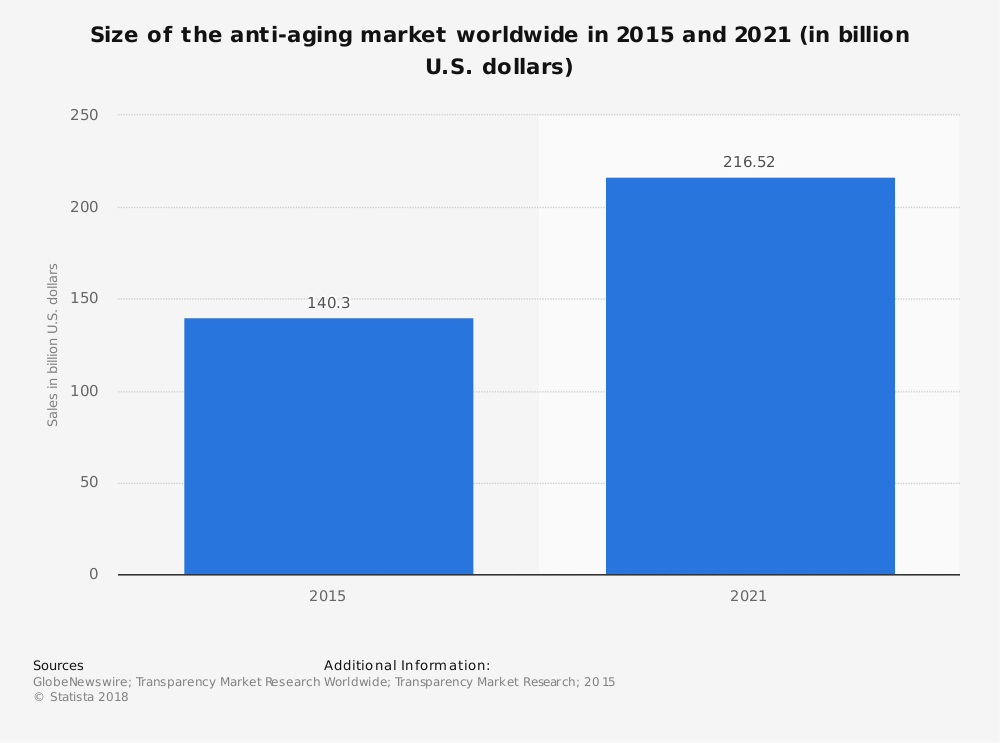What defines beauty within a society drives people to create it for themselves. The amount of pressure an individual may experience to maintain a youthful appearance is influential and everywhere. From the movies, to the television, to print and digital media, an attractive and youthful physical appearance is touted as a needed element for success. By taking advantage of the social pressures to conform to a certain state of youthfulness, the industry is able to generate billions in revenues each year.
That means there is one fact that the anti-aging industry cannot ignore. If you are comfortable in your own skin, then they lose a customer. It is in their best interest to make people feel insecure about their wrinkles, their gray hair, or anything else that could make someone feel self-conscious.
Interesting Anti-Aging Industry Statistics
#1. In 2015, the anti-aging market held a global value of $140.3 billion. With a forecast CAGR of 7.5%, the industry could hold a total value of $216.5 billion by 2021. (Statista)
#2. The largest geographic market for the anti-aging industry is the United States. About $60 billion in revenues is generated in the American market each year. (Statista)

#3. The leading cosmetics brand in the world today is L’Oreal, which had a total value of $13 billion in 2016. Gillette is the next-closest competitor, with revenues of $7.2 billion annually. (Statista)
#4. One of the most popular product lines offered by the anti-aging industry are skin care products. Sales of creams that are marketed as slowing the aging process generate about $1.15 billion each year. (Statista)
#5. In 2012, Americans spent more than $11 billion on cosmetic treatments. That was 5.5% more than the year before. The average benefit that a face lift can provide is about 10 years, while basic facial fillers may last 12-18 months. (Market Watch)
#6. Almost 489,000 botulinum toxin injections were given to people between the ages of 19-34 in the United States in 2012. That is more than double the number of injections given to the same age demographic in 2002. (Market Watch)
#7. Microdermabrasion has emerged as a pre-juvenation treatment for people under the age of 35 as well. The average cost of the procedure is about $154, which must be performed once per month. Starting at 30, then having the procedure performed for 40 years, comes with a total cost of $74,000. (Market Watch)
#8. Some doctors charge more than $1,000 per syringe for fillers that are used in anti-aging procedures. These treatments are usually not covered by health insurance either. (Market Watch)
#9. The global wellness products industry is valued at $569 billion, including anti-aging products as one of it segments. Cosmetics and toiletries, including anti-aging products, are valued at $333 billion. (Nu Skin)
#10. By 2025, the number of people who are above the age of 65 will outnumber children who are under the age of 5 for the first time in known human history. (Nu Skin)
#11. 4 out of 5 Baby Boomers say that they are taking steps to feel young and remain that way. (Nu Skin)
#12. 90% of consumers are interested in learning how to achieve, then maintain, a healthy lifestyle to support their anti-aging efforts. (Nu Skin)
#13. Although revenues in the U.S. market are expected to continue leading the industry, the fastest levels of growth by 2025 will be found in the Asia-Pacific (APAC) region. 82% growth is expected, compared to 76% growth in the United States. (Nu Skin)
#14. In 2016, the APAC region provided almost $13 billion in revenues to the anti-aging industry. (Technavio)
Anti-Aging Industry Trends and Analysis
The anti-aging industry is going to continue growing, even if there is a societal push for authenticity in one’s appearance. Even from a pure medical standpoint, the number of Americans who will be above the age of 65 by 2050 will be more than 20%. That’s 7 percentage points higher than it is today.
Since 2008, the number of doctors who have been certified to provide anti-aging care has grown to 26,000. That’s an increase of 9,000 American doctors gaining this certification in just 10 years.
We cannot stop the aging process. What we can do is help to improve the side-effects which come because of aging, helping everyone to look and feel at their best.
What holds this industry back is a lack of recognition for it. The American Board of Medical Specialties does not recognize anti-aging as a medical category. Anyone, from any specialty, can practice anti-aging medicine without much difficulty. Even something simple, like prescribing hormones, can be enough to classify a medical provider as part of the industry.
Then there is the fact that some of the most popular treatments offered by the anti-aging industry are not regulated. Items like bio-identicals provide a certain form of testosterone to men and women who experience weight gain and lower energy levels as they reach the middle ages.
With greater regulation may come better recognition. Should that occur, the anti-aging industry stands ready to experience explosive growth. Until then, expect the industry to continue growing in popularity as populations continue to get older.
Although millions of people visit Brandon's blog each month, his path to success was not easy. Go here to read his incredible story, "From Disabled and $500k in Debt to a Pro Blogger with 5 Million Monthly Visitors." If you want to send Brandon a quick message, then visit his contact page here.
